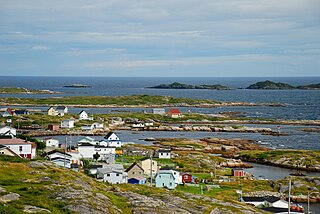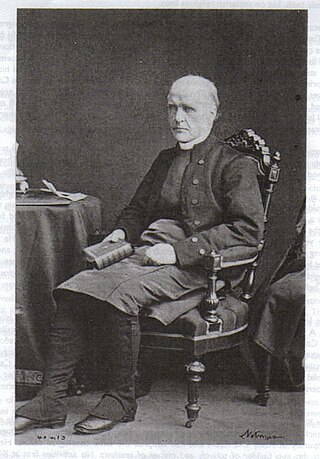Related Research Articles
Newtown is a part of the Municipality of New-Wes-Valley, located at the North end of Bonavista Bay in the province of Newfoundland and Labrador, Canada. The approximate population is 400. Settlement in Newtown originated around 1850 when people relocated from nearby areas. Newtown is well known for being built on many small islands, and is the home of the Barbour Living Heritage Village.
Wesleyville is a small coastal community in Newfoundland and Labrador, Canada. It is located on the Straight Shore of Bonavista Bay, on the northeast coast of Newfoundland, near the communities of Greenspond and Newtown. It was settled in the early 19th century, when residents relocated from nearby islands.

Greenspond is a community in the province of Newfoundland and Labrador, Canada.

Edward Feild was a university tutor, university examiner, Anglican clergyman, inspector of schools and second Bishop of Newfoundland.
Safe Harbour is an abandoned outport on the northeast coast of Newfoundland in the Canadian province of Newfoundland and Labrador. Settled by 1870, it was abandoned in 1955.

The province of Newfoundland and Labrador covers the period from habitation by Archaic peoples thousands of years ago to the present day.
Carmanville is a Canadian community in the province of Newfoundland and Labrador.
Musgrave Harbour is a town and designated place in the Canadian province of Newfoundland and Labrador.
Bay de Verde is an incorporated town in Conception Bay on the northern tip of the Bay de Verde Peninsula of Newfoundland and Labrador, Canada. The first recorded inhabitants at Bay de Verde arrived in 1662. Bay de Verde became an incorporated town in 1950.
Flowers Island was one of the communities in an area on the northeast coast of the Island of Newfoundland called Bonavista North. These communities have a shared history in that they were settled by people from England, predominantly from the West Country—Dorset, Devon Somerset and Hampshire.
Cape Freels is one of the communities that comprise an area on the northeast coast of the Island of Newfoundland, called Bonavista North, in the province of Newfoundland and Labrador, Canada. These communities have a shared history in that they were settled by people from England, predominantly from the West Country - Dorset, Devon, Somerset and Hampshire.

Lumsden, formerly known as Cat Harbour, is a community located on the Straight Shore of Newfoundland in Newfoundland and Labrador, Canada, near communities such as Musgrave Harbour and Newtown. Lumsden formerly consisted of two settlements, Lumsden North on the tip of a sandy peninsula and Lumsden South on the main road. Although the harbour in Lumsden is not ideal because it is not sheltered, Lumsden has excellent fishing grounds.
Ladle Cove is a designated place in the Canadian province of Newfoundland and Labrador. It is along the Straight Shore on the island of Newfoundland.
Pool's Island is an incorporated community of Badger's Quay-Valleyfield-Pool's Island in the province of Newfoundland and Labrador, Canada. It is now part of the town of New-Wes-Valley.
Fair Island, also called Vere Island, is a former community on the northeast coast of the island of Newfoundland. Together with other nearby communities it comprises an area called Bonavista North. These communities have a shared history in that they were settled by people from England, predominantly from the West Country - Dorset, Devon Somerset and Hampshire.
Swain's Island, Newfoundland, is actually a group of eight islands on the north side of Bonavista Bay, southeast of Wesleyville. All of these islands once had inhabitants but eventually all of them were resettled, mostly to Wesleyville.
Pinchard's Island was one of the communities that comprise an area on the northeast coast of the Island of Newfoundland, called Bonavista North. These communities have a shared history in that they were settled by people from England, predominantly from the West Country - Dorset, Devon Somerset and Hampshire.
Robert Dyer left the village of Heytesbury, in the county of Wiltshire, England, to voyage across the Atlantic Ocean to serve as a Newfoundland School Society teacher in the fishing community of Greenspond, Newfoundland. The Newfoundland School Society was established by the English merchant, Samuel Codner, who realised the need for educating the poor population of Newfoundland, and other poor colonies in British North America as well. Dyer first arrived in Newfoundland in 1839 and began his career as a teacher. He stayed in Greenspond for twenty years, earning the respect and admiration of the inhabitants and those who met or worked with him. Dyer was also ordained a Church of England Deacon in 1849; therefore, his work in Greenspond consisted of both teaching and ministerial duties. Dyer and his family later moved to Alberton, Prince Edward Island, where he was a minister in a Church of England Parish.
Intercontinental Church Society (ICS) is a global Anglican mission organisation. ICS is a voluntary Evangelical Society, a full member of the Partnership for World Mission, and therefore a recognized agency of the Church of England for overseas work through the medium of the English language. It supports ministry to people from all over the world and calls on people at home for prayer and financial support. Their current mission statement is "mission and ministry in English for everyone."
Bishops College was a high school located in central St. John's, Newfoundland and Labrador. It was next to another high school called Booth Memorial High.
References
- ↑ J.D Mullins, Our Beginnings: Being a Short Sketch of the History of the Colonial and Continental Church Society (London: Colonial and Continental Church Society, 1923)
- ↑ The Newfoundland School Society Annual Reports, Center for Newfoundland Studies, Memorial University; Microfilm 619, A-322 and A-323, 1823-1836.
- ↑ Phil McCann, 1998
- ↑ The Society's Family Tree
- ↑ Based on the research of archivist, Linda White, editor of the Greenspond Letter.
- 1 2 3 4 Encyclopedia of Newfoundland and Labrador
- 1 2 3 4 5 W. Gordon Handcock
- ↑ 1st Annual Reports of the Committee of the Society for Educating the Poor of Newfoundland
- ↑ Our History
- ↑ Annual Reports of the Committee of the Society for Educating the Poor of Newfoundland, Center for Newfoundland Studies, Memorial University
- ↑ Journal of the House of Assembly